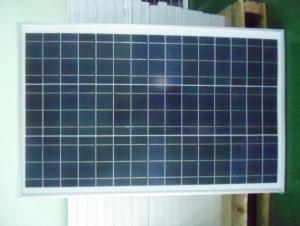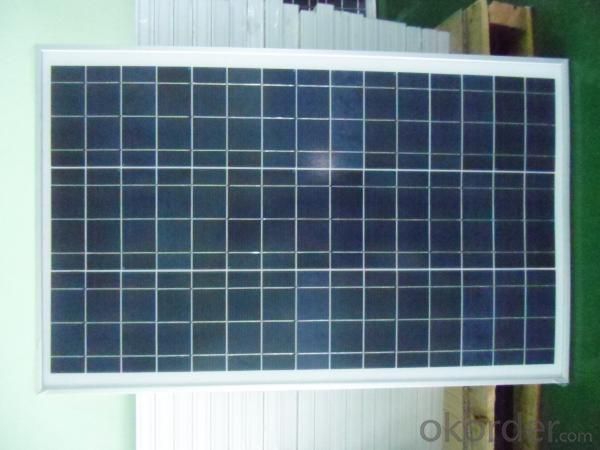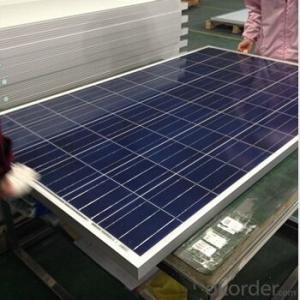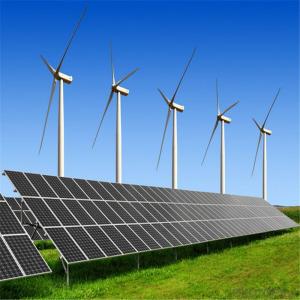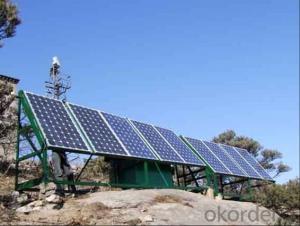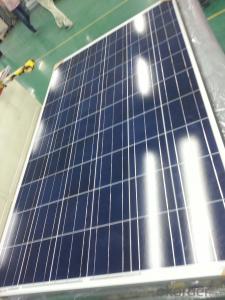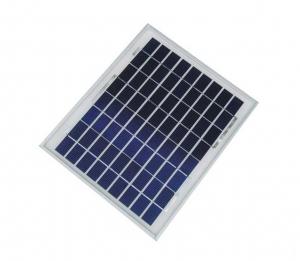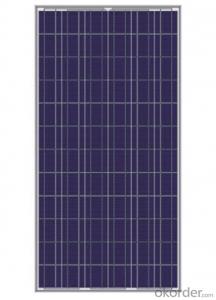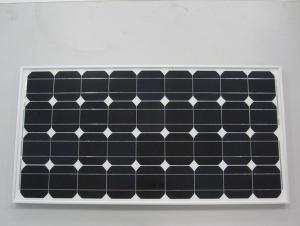Sunergy Solar Poly Panel (130-150w)
- Loading Port:
- Shanghai
- Payment Terms:
- TT
- Min Order Qty:
- 1 pc
- Supply Capability:
- 100000/month pc/month
OKorder Service Pledge
OKorder Financial Service
You Might Also Like
Solar Poly Panel(130W-150W)
Introduction of Solar Poly Panel(130W-150W)
CNBM Solar photovoltaic (PV)module is designed for large electrical power requirements. It is the optimal choice for both on-grid and off-grid power systems. CNBM Solar panel offers high performance of power per square foot of solar array.Poly- or multicrystalline silicon(poly-Si or mc-Si): made from cast square ingots — large blocks of molten silicon carefully cooled and solidified. Poly-Si cells are less expensive to produce than single crystal silicon cells, but are less efficient. US DOE data shows that there were a higher number of multicrystalline sales than monocrystalline silicon sales.
Characteristics of Solar Poly Panel(130W-150W)
I Solar Cell : High efficiency crystalline solar cell. Even if under the weak light, the solar module can produce maximum power output.
II Tempered glass (toughened glass): Anti-reflecting coating and high transmission rate glass increase the power output and mechanical strength of solar module.
III EVA and TPT: Using high quality EVA and TPT to prevent destroying and water.
IV AI frame: Without screw, corner connection. 6 holes on the frame can be installed easily.
V Junction box: Multi function junction box with water proof.
VI Long lifetime: ≥25 years; Less power decrease.
VII Good performance of preventing from atrocious weather such as wind and hails.
VIII Resisting moisture and etching effectively, not effected by geology. .
Standard Test Conditions of Solar Poly Panel(130W-150W)
The opto-electrical specifications shown below are stabilized values being measured at Standard Test Conditions of multicrystalline silicon Solar Panel, Irradiance: 1000W/m2, Spectrum: AM1.5 at 25°C, The info below is subject to manufacturing tolerances. Where appropriate minutes of measurement are available and are used for the dimensioning of the installation.
Advantages of Solar Poly Panel(130W-150W)
• CNBM Solar performance guarantees for 25 years
• 2 years guarantee for workmanship for multicrystalline silicon Solar Panel
• Timeliness of delivery
CNBM International Corporation's products including Monocrystalline Solar Panel, Polycrystalline Solar Panel ( multicrystalline silicon Solar Panel) have received and enjoyed famous reputation in many countries and regions in the world .As a solar panel manufacturer in China, we strive to provide our customers with excellent service, superior products and unmatched value.
Characteristics of Solar Poly Panel(130W-150W)
Max Power Voltage Vmp (V) | 17.5V | 17.8V | 18.0V |
Max Power Current Imp (A) | 7.42A | 7.86A | 8.33A |
Open Circuit Voltage Voc (V) | 22.0V | 22.4V | 22.6V |
Short Circuit Current Isc (A) | 8.10A | 8.34A | 8.91A |
Max Power Pm (W) | 130W | 140W | 150W |
Temperature Coefficient of Cells
NOCT | 47℃±2℃ |
Temperature Coefficients of Isc (%/℃) | 0.064 |
Temperature Coefficients of Voc (%/℃) | -0.33 |
Temperature Coefficients of Pmp (%/℃) | -0.45 |
Mechanical Data of Solar Poly Panel(130W-150W)
Power | 130W/140W/150W |
Dimension | 1470×670×30mm |
Weight | 11.7kg |
Tolerance | ±3% |
The dimension of the modules can be changed according to the demand of clients
Limits of Solar Poly Panel(130W-150W)
Operating Temperature | –40 °C to +85°C |
Storage Temperature | –40 °C to +85°C |
Max System Voltage | 700V |
Guarantee of Solar Poly Panel(130W-150W)
Products Guarantee | 2 yrs free from defects in materials and workmanship |
Performance Guarantee | No less than 90% within 10yrs and no less than 80% within 20yrs |
Certificates | IEC, ISO, TUV, CE |
The Equipment of Solar Poly Panel(130W-150W)
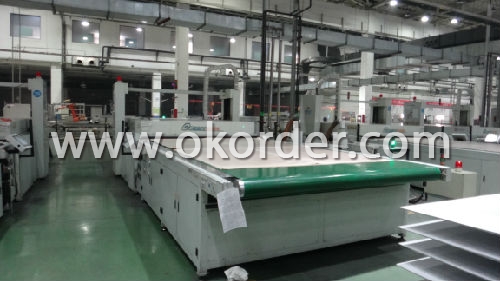
The Production Line of Solar Poly Panel(130W-150W)
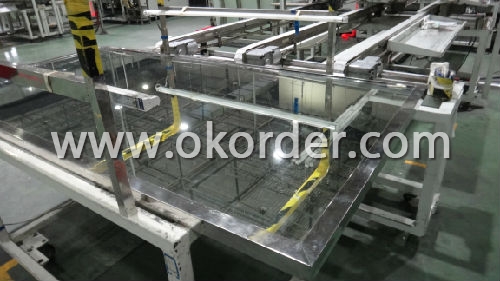
- Q: i need how a solar panel works, if possible make as easy to understand as possible like because of this , this happens and if you could please put a web source you got it from
- How okorder /... Use the next page link to flip through the article.
- Q: What is the difference b/w them which one is better .
- how much does these pannels way and which are the most efficient?
- Q: What direction do solar panels usually point? North? East? South? West?
- Oh wow, please ignore approx 50% of the answers here. We live off-grid and solar is my business. If you are in North America, they should face SOUTH. The comment about them facing the equator is accurate. What has not been said though, is the angle they should be at. For optimal sun exposure, the angle from horizontal for the panel should be equal to your latitude. So if you live in Colorado for example, at approximately 40 degrees latitude, your panel should be at 40 degrees from horizontal.
- Q: I contend:As far as the solar panels causing global warming I'll try to explain. If you put a black panel on the ground or on your house and don't connect it to anything, it will absorb solar energy (heat) during daylight and release it at night (radiation). The net heat gain is zero. If you hook up a solar panel in the same place but hook it up to batteries, charge the batteries during sunlight hours and using that energy to electrically heat the home at night. The panels will absorb solar energy during the day but will convert that to electrical energy in the batteries instead of radiating it back into space at night. The result is a net gain in earth's temperature.Right or wrong?
- Third Law of Thermodynamics (in normal speak): “Not only can you never get ahead, you can’t even break even.” This is a truism that applies to all activities involving energy exchange (and almost everything else as well). Energy in the form of solar radiation falls on the earth. That energy is absorbed by the planet (everything) and heat results. Some portion of that energy is lost in the absorption process and the net released as heat is less than that absorbed from the sun. This is true in all cases. Solar panels, both photovoltaic and heat collectors are subject to the Third Law and they all lose some of the radiant energy striking them in the process of converting that energy into either hot water (or whatever fluid) or electrical energy. Regardless of the process there is always a net loss of energy. The time delay you mention has no bearing on the total heat gain or loss for the planet. In fact the “solar panel effect” reduces the net energy put back into the ecosystem because it introduces another iteration of energy loss through conversion. The Holy Grail of energy conservation it the ability to use, store or recover the entire amount of energy produced regardless of the source of that energy, burning hydrocarbons, geothermal heat exchange, solar radiation, mice on treadmills …..all forms of energy suffer a net loss in any exchange! If we could avoid that loss we could dramatically reduce the heat lost into the atmosphere or ground water and our net energy gain would also be dramatic! Check out the super cooled circuits in use to reduce resistance in sophisticated electronic equipment for a good example of the energy savings. (Of course the savings do not account for energy lost in the cooling process. In any event NO….. solar panels do not contribute to global warming via their operation. (Their manufacture is another story altogether!)
- Q: Someone Said It costed them 50,000 To Install Solar Panel In their House and 35,000 For Installation. Is that true?
- It depends on the number and size of the panels. The minimum charge for a small bungalow would be at least $20,000 labor and material.
- Q: I thought that I had a fairly good understanding of watt's law, but i'm starting to doubt myself.If I have a load of 4500watts at 240 volts, how many watts of solar panels do I need, if the solar panels are at 2v?Yes, Yes... I have a charge controller, batteries, etc...So the way I looked at this at first:watts = volts * amps For the load4500 = 240 * xx would be 8.75aFor the power source (each solar panel)00 = 2 * xx would be 8.3a8.75 / 8.3 = 2.25, rounded up = 3So... based on that I came to the conclusion that I needed 3 solar panels...But... then I was thinking. Does it work that way?Or do I need 4500 / 00 = 45, aka 45 solar panels?In other words...If I have a 2v power source, how many watts do I need to drive a load of 4500w at 240v?ThanksMatt
- The easy way is to just use the power values. You need 4500W. Each solar panel delivers 00W (from a value in your working). Therefore you need 4500/00 = 45 solar panels. This is a crude calculation, ignoring efficiencies, voltage conversion losses and losses due to internal resistance. You would probably need quite a few more than 45 panels. ___________________________ I'll explain how to do the calculation your way. Each solar panel delivers 00W with a voltage of 2V. So the current is 00/2 = 8.333A. Each solar panel delivers 8.333A at 2V. But you require 8.75A at 240V panel delivers 00W. To get 4500W, you need: 8.75/8.333 = 2.25 times more panels to increase the current AND 240/2 = 20 times more panels to increase the voltage. So overall you need 2.25 x 20 = 45 panels. Of course if the power output of each solar panel is not 00W, you have to change the above calculation accordingly.
- Q: Is it possible for a 2V rated panel to charge a bank of batteries equal to around 36V? I believe that the panels should equal or exceed the voltage of the batteries but, I'm not for certain.
- With a 2 volt power source (solar panel, battery charger, vehicle charging system, etc...) you can charge three 2 volt batteries in parallel circuits then switch to a series circuit through a series/parallel switch to get 36 volts output. I've done this with my electric scooter so I can charge it with my pickup through the lighter socket when I'm away from home. It works great! When at home I just leave the switch in the 36 volt position, plug the charger in the wall receptacle and the charger puts out 36 volts. Actually 2 volt lead acid batteries have 2.6 volts when fully charged so the charging source has an output of 3.6 to 4.2 volts to effect a complete charge. In the series circuit the fully charged batteries would put out 37.8 volts so the charger would have an output of 40.8 to 42.6 volts.
- Q: Can solar panels be installed on a shaded area?
- Solar panels are most effective when placed in direct sunlight, so installing them in a shaded area would significantly reduce their energy production. However, there are technologies available, such as bifacial solar panels or solar trackers, that can optimize energy generation in partially shaded areas.
- Q: OK so how do these solar panels supplement the AC from the grid? Like do they invert the output of the solar panels and sync two AC sources together? If so how and with what? Or do they convert the AC from the grid to DC and then supplement and then invert it? If so how and with what? Thanks
- The okorder /
- Q: Can solar panels be used in areas with high levels of seismic activity?
- Yes, solar panels can be used in areas with high levels of seismic activity. However, special design considerations and installation techniques may be required to ensure their stability and withstand potential earthquake forces.
Send your message to us
Sunergy Solar Poly Panel (130-150w)
- Loading Port:
- Shanghai
- Payment Terms:
- TT
- Min Order Qty:
- 1 pc
- Supply Capability:
- 100000/month pc/month
OKorder Service Pledge
OKorder Financial Service
Similar products
Hot products
Hot Searches
Related keywords

